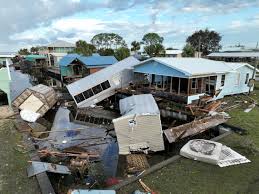Homeowners across the United States are facing unprecedented increases in property insurance premiums, as climate-related disasters continue to multiply in frequency and severity. From wildfire-prone California to storm-battered states along the East Coast, rising risks are forcing insurers to hike rates — or pull out of certain markets entirely.

According to the latest Mortgage Monitor from Intercontinental Exchange Inc., the average annual insurance cost for a mortgaged single-family home in the U.S. climbed to nearly $2,370 in the first half of 2025. That’s a 4.9% increase since the beginning of the year — the steepest jump on record.
Disaster Zones See Steepest Premium Hikes
While insurance costs are rising nationwide, the most dramatic increases have been concentrated in areas hit hardest by recent natural disasters.
In California, which experienced widespread wildfires in January, insurance costs have surged. In Los Angeles, where firestorms destroyed entire neighborhoods, premiums climbed 9% during the first six months of the year — a 20% increase compared to mid-2024.
North Carolina and South Carolina also experienced sharp premium spikes, driven by the lingering aftermath of Hurricane Helene, which caused destructive flooding across both states in late 2024.
Climate Change Drives Industry Instability
The growing cost of property insurance reflects deeper instability in the housing and insurance markets. As climate change increases the frequency and intensity of extreme weather, insurers are being forced to rethink how — and where — they do business.
Many are raising premiums to cover mounting losses. Others are scaling back coverage, refusing to renew policies, or withdrawing from high-risk areas altogether. For homeowners in vulnerable regions, the result is a shrinking pool of insurers and a dramatic rise in premiums — if coverage is available at all.
California Still Has Relatively Low Premiums — For Now
Despite its wildfire exposure, California still maintains some of the lowest average home insurance premiums in the country. This is largely due to state regulations that limit how much insurance companies can increase rates.
However, analysts warn that this situation may not be sustainable. As wildfire seasons grow longer and more destructive, insurers are lobbying for changes to rate-setting policies. Some have already begun to reduce their presence in the state, signaling that costs may rise even more in the years ahead.
Southern States Pay the Most for Insurance
In contrast, states across the South and Midwest — particularly those prone to hurricanes, storms, and hail — bear the highest property insurance costs in the nation.
In Florida, a series of legislative reforms has attempted to stabilize the troubled insurance market and attract private insurers back into the state. For years, Citizens Property Insurance Corporation, the state-run provider, served as the last resort for many homeowners unable to find affordable coverage elsewhere.
Those reforms are starting to have an impact. In Miami, where insurance is more expensive than anywhere else in the country, the percentage of mortgage-holding homeowners with Citizens coverage has dropped from 46% to 27% over the past 18 months. Although this shift signals a return of private carriers, it also means higher premiums for many policyholders.
The Path Forward: Higher Costs, Fewer Options
As the climate crisis deepens, experts expect that home insurance will continue to grow less affordable and harder to access, especially in high-risk regions.
The insurance industry is adapting by raising rates and tightening coverage criteria, but that leaves homeowners facing difficult decisions — pay more, accept reduced coverage, or go without insurance altogether.
Without meaningful investments in climate resilience, infrastructure, and disaster mitigation, the gap between risk and affordability is likely to widen. For millions of Americans, rising insurance costs are no longer just a financial inconvenience — they are becoming a barrier to homeownership and long-term housing stability.

